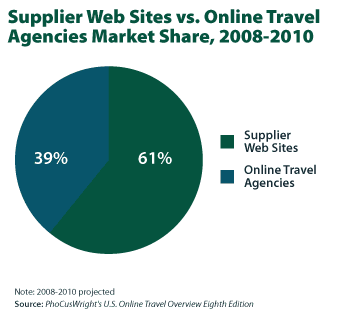As the online leisure/unmanaged business travel market in the U.S. has matured, supplier Web sites and online travel agencies (OTAs) appear to have reached relatively stable market share. According to PhoCusWright’s Online Travel Overview Eighth Edition, supplier sites account for 61% of the online market vs. 39% for OTAs in 2008. This balance is projected to hold steady through 2010, although intense competition and tumultuous dynamics underlie this uneasy equilibrium.
From 2003–2006, a period of strong overall growth for travel and the online market in particular, suppliers aggressively grew their online share through relentless marketing and incentives to drive consumers to book direct on their Web sites. But as the economy began to sputter in the second half of 2007, consumer demand slackened and OTAs started to benefit from a limited countercyclical lift.

According to PhoCusWright’s Consumer Travel Trends Tenth Edition, 47% of online travelers cited online travel agencies as their primary shopping method in 2007 vs. 40% in 2006. But this is not necessarily translating into market share in revenue terms. Increasingly, OTAs and supplier Web sites are attracting very different traveler segments. OTAs are attracting more infrequent leisure travelers, who may take just a few trips a year and are more price-sensitive. Suppliers, by comparison, are the preferred destination of the more frequent, loyal leisure/unmanaged business traveler, who may be less concerned with price and more interested in schedule, convenience and booking with specific suppliers.
There are varying nuances to this dynamic across the different travel product categories. Rising airfares and weakening consumer confidence is fueling the hunt for bargain fares, particularly on OTAs and metasearch sites. Declining hotel occupancy and average daily rates are motivating hotels to push more discounting through online intermediaries, especially opaque and packaging channels, which are benefitting most from the economic downturn. Priceline and Hotwire have shined brightly amid a gloomy overall travel landscape.
Dollars vs. Eyeballs
So OTAs may have an edge in eyeballs, with more foot traffic into their online stores. But that traffic converts far less, and is much more driven by price. Suppliers, on the other hand, are winning in dollars. They may have fewer customers, but their customers travel more and are likely to spend more per trip.
These dynamics underpin the current blurring of travel distribution business models, one of the central tenets of the Perfect Storm. Suppliers are trying to wring more dollars out of frequent, loyal bookers, which means increased focus on personalization, loyalty and community. OTAs, by comparison, are trying to wring any dollars out of their mass of unconverted lookers, as the almighty transaction gives ground to eyeballs and ads.
For in-depth analysis of travel distribution trends, including segment-by-segment assessment of supplier Web site and online travel agency dynamics and strategies, purchase PhoCusWright’s U.S. Online Travel Overview Eighth Edition. This annual report presents comprehensive analysis and forecasts of the U.S. total and online leisure/unmanaged business travel market, covers all major travel product segments, and provides detailed channel segmentation by supplier Web sites, online travel agencies and offline channels.
By Douglas Quinby and Carroll Rheem
The report is immediately available at www.phocuswright.com for Global Edition subscribers.
Source: PhoCusWright FYI




